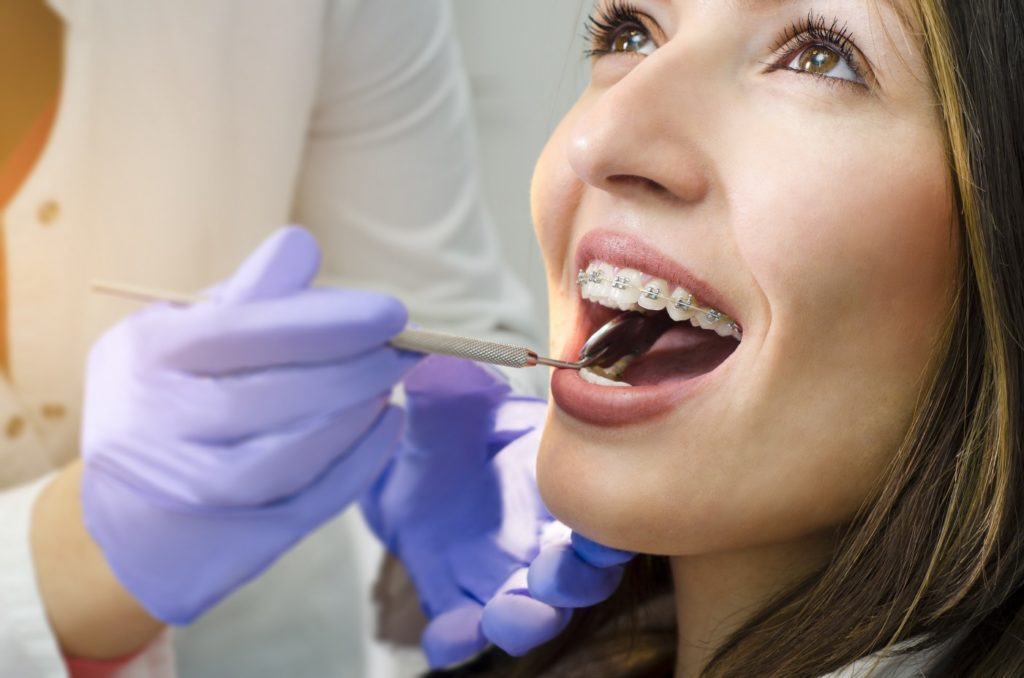Did you know that we treat routinely patients of all ages here at Shaw Orthodontics? Though many of us may imagine a teenager when we’re thinking of orthodontic treatment, children, teens, and adults alike can all benefit from the care of an experienced orthodontist like Dr. Shaw. In fact, we’re seeing more adults seeking treatment than ever before, with as many as 1 in every 3 of our orthodontic patients being over the age of eighteen! Many of them are interested in braces for adults, but have questions about their crowns, fillings, and implants.
Both traditional metal braces and clear braces are becoming increasingly popular with adults looking to straighten their smile and improve oral health. One question we are frequently asked by those contemplating braces is if they’d be compatible with dental treatments that are already in place, such as crowns, dental implants, or fillings. It’s a valid question, but the answer is a bit complex, so we’ve put together information on this topic below. Keep reading to learn more about the basics of treatment with crowns, implants, or fillings in place!
Will braces work with crowns?
If you’ve had previous dental treatment where you’ve received dental crowns, braces are still a possibility. If Dr. Shaw feels that metal, clear, or lingual braces are a good fit for you, the individual brackets can be adhered to the crowns in the same manner as to your natural teeth. The only difference is in the type of adhesive we use.
Crowns can also be put on your teeth after the course of your orthodontic treatment if you’re looking for a total smile makeover! Once your teeth have been straightened and the braces removed, crowns can be applied to match the color or shape of your teeth. Combining crowns with orthodontic treatment can give you a brand-new smile that is bright, even, and fully functional.
Will braces work with fillings?
Many adult patients we see come to us with fillings. This is a wise move, as crooked or misaligned teeth can actually increase the risk of cavities and tooth decay that necessitated those fillings in the first place. Food debris and plaque can accumulate in the gaps between the teeth, while crowded or crooked teeth make it difficult to clean these areas thoroughly.
If you have fillings and are interested in orthodontic treatment with us, Dr. Shaw will want to first assess your whole mouth. This will give him the information he needs to determine how to proceed without disturbing your existing fillings. While the material of your fillings shouldn’t affect treatment, bigger fillings may require spacers. These are simply tiny rubber bands that are placed between the teeth in order to provide extra space for movement. After the spacers have done their work, treatment should be able to proceed as normal!
If Dr. Shaw discovers any untreated cavities during your examination, they will need to be filled or restored before we can begin the active phase of treatment. And although we do stress the importance of good oral hygiene throughout the treatment process, sometimes cavities can develop while you’re wearing braces. You can get a filling or restoration during orthodontic treatment, but because braces can be difficult to work around, occasionally a bracket will need to be removed in order to complete the filling. This can set your treatment plan back a bit, so we encourage you to do your best to avoid cavities while undergoing orthodontic treatment, and consult with us and your dentist before getting a cavity treated.
Our expert team is happy to help you with advice on creating and maintaining the best oral hygiene routine you can manage while you’re in braces! We’ll show you how you can most effectively clean your teeth with braces to ensure that you have the lowest risk or cavities or gum disease. And of course, we’re always around to answer any questions or concerns you may have about dental hygiene and your oral health.
Will braces work with dental implants?
Adult patients with crowns, fillings or implants, or who have one or more missing teeth can sometimes benefit from orthodontics. For example, braces can be used to close the gap created by the missing tooth. For patients already dealing with overcrowding, this can be an effective option. If there’s a missing tooth that needs to be replaced, braces can be used to reserve a space for a restoration, replacement, or implant in the future.
If orthodontics and dental implants are both required, we will generally recommend that you complete your treatment with braces first. This is because once an implant is placed, it cannot move like a regular tooth. The implant is fixed into the jaw and does not contain the ligaments necessary for tooth realignment. For many patients, orthodontic treatment may be needed to create enough space for the new implant, and to move the roots of the neighboring teeth into the correct positions.
Less frequently, it may make more sense for the dental implant to be placed before orthodontic treatment begins. If the teeth that surround the implant aren’t targeted for orthodontic treatment, there’s generally no problem with placing the implant prior to braces. The same holds true for dental implants that will be serving as an anchor point so that the appropriate forces can be applied to reposition the other teeth.
If you are a patient that has older dental implants, some natural crowding of the other teeth may have occurred as you’ve aged. If you’ve noticed an implant looking out of place in recent months, we can use braces to move the teeth around it to achieve a more natural arrangement. If your dental implant is in a subpar position before beginning orthodontic treatment, it may look out of place once the rest of your teeth are aligned. In that case, you can either accept the slight imperfection in your smile, or choose to remove the implant, complete treatment, then replace the implant once your braces are removed.

Get the healthy smile you’ve always wanted with Shaw Orthodontics
Here at Shaw Orthodontics, we love seeing adult patients invest in their oral health through orthodontic treatment! After all, it’s never too late to straighten your smile. As a board-certified orthodontist, Dr. Shaw has many years of training and experience in both dentistry and orthodontics. That means he is an expert in accommodating any previous, current, or future dental work! If you’re in Rockwall, Watauga, or the surrounding area and would like to learn more about getting a straight smile with crowns, fillings, or dental implants, we’d love to hear from you! Get in touch today to schedule your FREE consultation.

